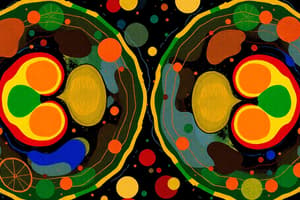Podcast
Questions and Answers
Mitosis is primarily responsible for creating gametes such as eggs and sperm.
Mitosis is primarily responsible for creating gametes such as eggs and sperm.
False (B)
Cells spend 90% of their time in interphase and only 10% in mitosis.
Cells spend 90% of their time in interphase and only 10% in mitosis.
True (A)
During interphase, DNA is duplicated only once before mitosis starts.
During interphase, DNA is duplicated only once before mitosis starts.
True (A)
The structure of a chromosome consists of both DNA and protein.
The structure of a chromosome consists of both DNA and protein.
The number of chromosomes in a human body cell nucleus is 23.
The number of chromosomes in a human body cell nucleus is 23.
In the metaphase stage of mitosis, chromosomes line up in the middle of the cell.
In the metaphase stage of mitosis, chromosomes line up in the middle of the cell.
After duplication, a cell contains 46 chromosomes but 92 chromatids.
After duplication, a cell contains 46 chromosomes but 92 chromatids.
The anaphase stage involves the chromosomes lining up in preparation for splitting.
The anaphase stage involves the chromosomes lining up in preparation for splitting.
Telophase results in the formation of two identical daughter cells with 46 chromosomes each.
Telophase results in the formation of two identical daughter cells with 46 chromosomes each.
Meiosis produces four daughter cells that have 46 chromosomes each.
Meiosis produces four daughter cells that have 46 chromosomes each.
Cytokinesis is responsible for the final separation of cells during mitosis only.
Cytokinesis is responsible for the final separation of cells during mitosis only.
In meiosis, genetic variation is achieved through the process of crossing over.
In meiosis, genetic variation is achieved through the process of crossing over.
During interphase, the number of chromosomes doubles to 92 before meiosis begins.
During interphase, the number of chromosomes doubles to 92 before meiosis begins.
Meiosis is often described as a reduction division.
Meiosis is often described as a reduction division.
Sperm and egg cells contain 46 chromosomes each.
Sperm and egg cells contain 46 chromosomes each.
Homologous chromosomes are identical in size and genetic content.
Homologous chromosomes are identical in size and genetic content.
Flashcards are hidden until you start studying
Study Notes
Mitosis
- Mitosis is a type of cell division performed by most body cells, essential for growth and repair.
- It produces identical cells, ensuring that lost or damaged cells are replaced accurately.
- Mitosis does not produce gametes (egg or sperm cells).
- Cells spend 90% of their time in Interphase, where daily functions and DNA replication occur, while mitosis occupies 10%.
- Cells contain a nucleus, which houses DNA; new cells must share the same DNA as the original.
- Chromosomes, composed of DNA and protein, organize genetic material for efficient movement during division.
- Most human body cells contain 46 chromosomes, which must duplicate before mitosis.
- Counting chromosomes is done by centromeres, not chromatids; thus, during duplication, cells still have 46 chromosomes.
- Mitosis consists of four main stages, dubbed PMAT: Prophase, Metaphase, Anaphase, and Telophase.
Stages of Mitosis
- Prophase: Nucleus disappears, chromosomes condense and become visible.
- Metaphase: Chromosomes align at the cell's center and attach to spindle fibers.
- Anaphase: Sister chromatids separate and are pulled to opposite ends of the cell.
- Telophase: Chromatids reach poles, decondense, and new nuclei form, initiating cell division.
- Cytokinesis: Final phase where the cytoplasm splits, resulting in two identical daughter cells.
Meiosis
- Meiosis is a two-stage cell division process producing four daughter cells, each with half the genetic material.
- It takes place in reproductive organs (testes and ovaries) to produce gametes.
- Meiosis ensures organisms maintain the correct chromosome number during sexual reproduction and promotes genetic diversity.
- Sperm and egg cells each contain 23 chromosomes, whereas the starter cell has 46 chromosomes.
- Females begin with primary oocytes, while males start with primary spermatocytes.
- Interphase occurs before meiosis and involves cell growth, DNA replication, and ongoing cell functions.
- Similar to mitosis, sister chromatids are considered attached during interphase, so there are still 46 chromosomes.
- During meiosis, the count becomes 46 chromosomes and 92 chromatids, followed by two rounds of PMAT, leading to a reduction in chromosome number.
Stages of Meiosis
- Prophase I: Chromosomes condense and become visible; the nuclear membrane breaks down. Centrioles move to cell poles, homologous pairs align, and crossing over occurs, exchanging genetic material.
Studying That Suits You
Use AI to generate personalized quizzes and flashcards to suit your learning preferences.




